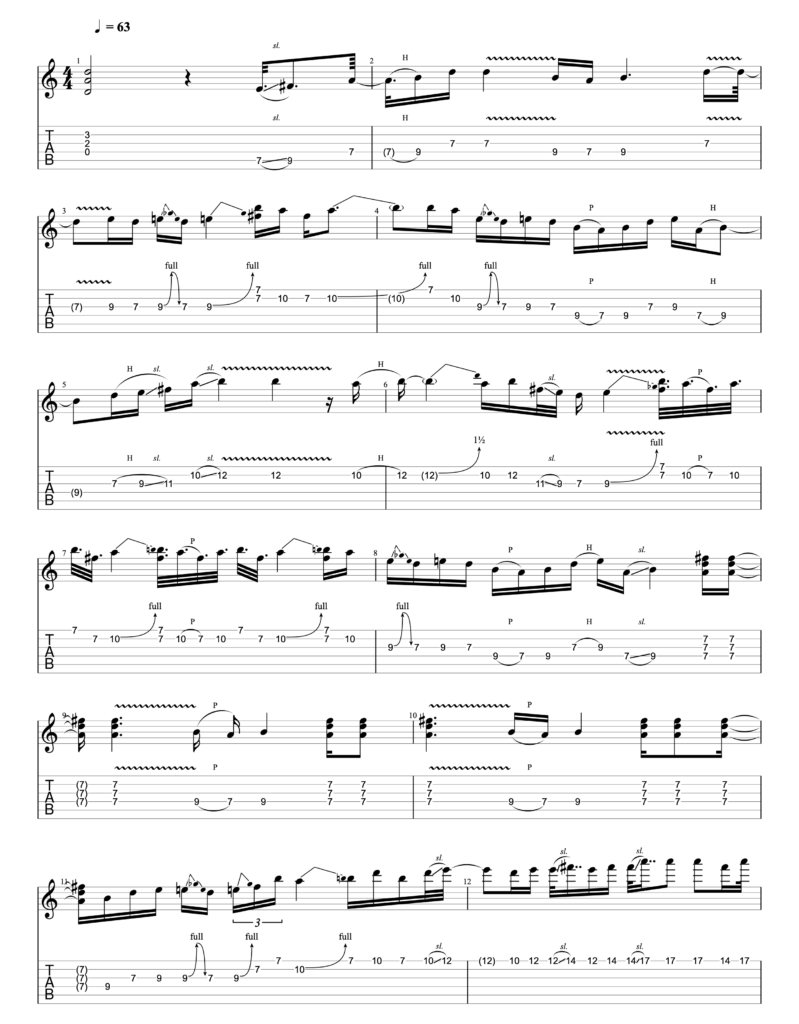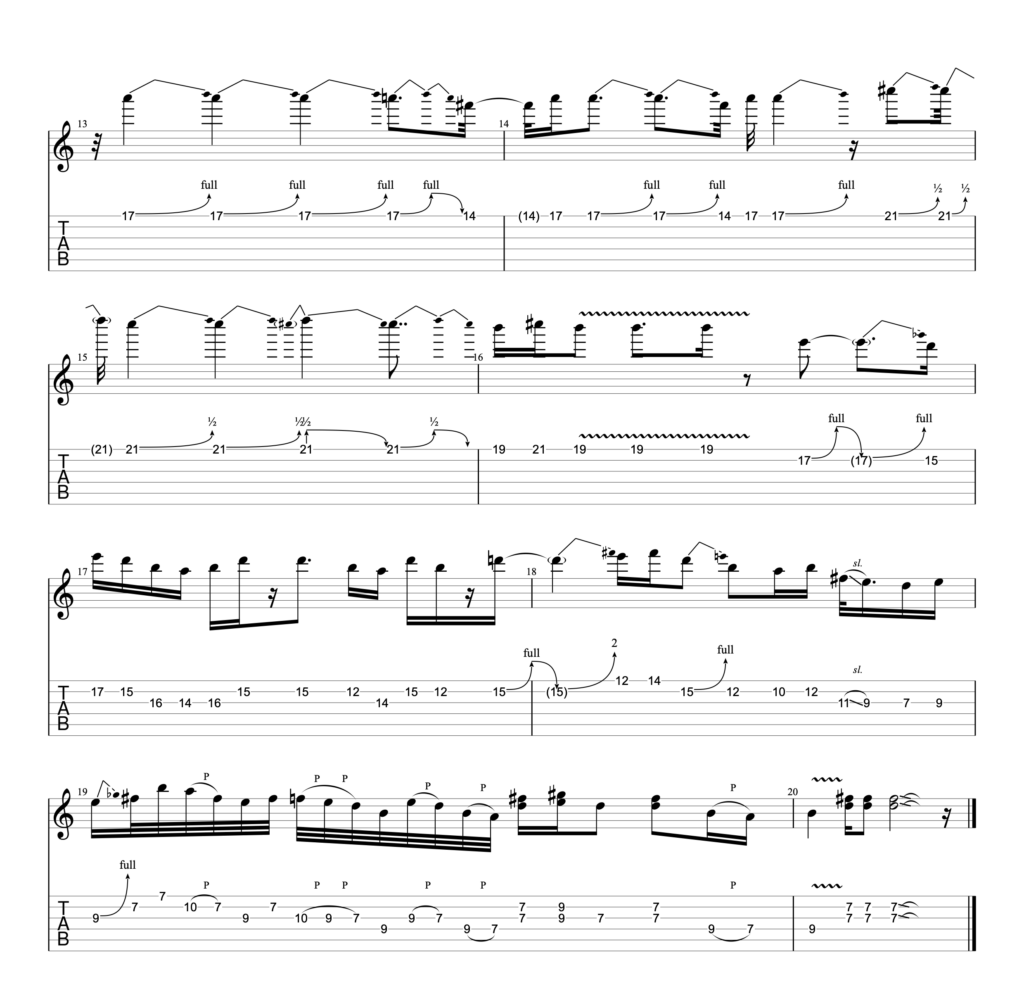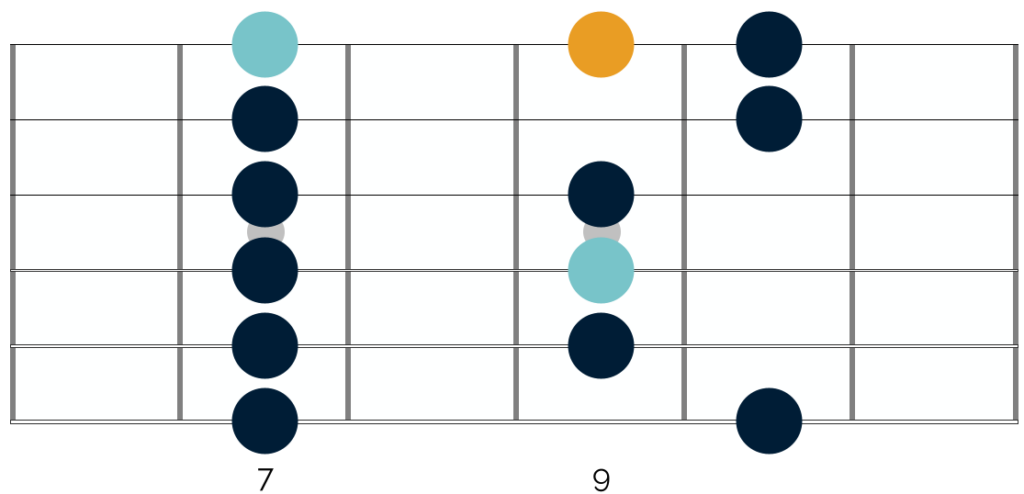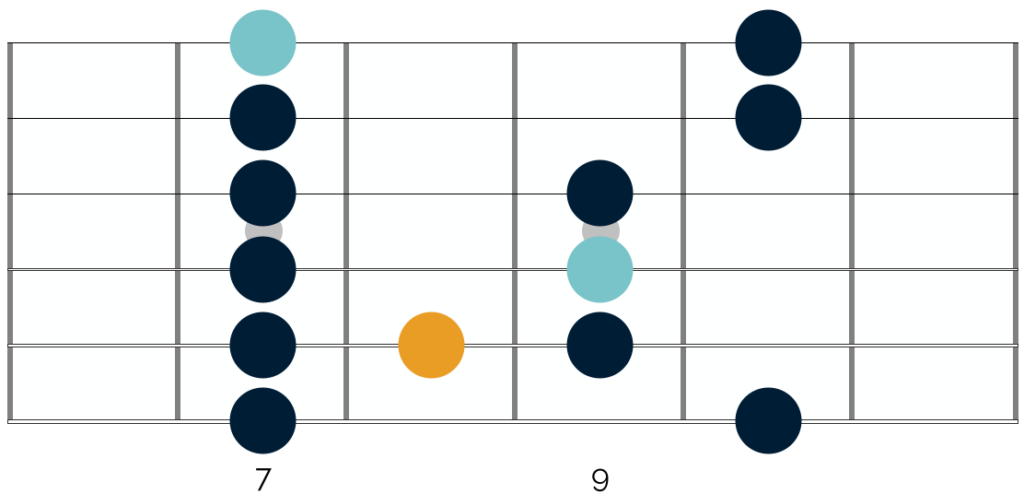Now that we have looked at both solos in Comfortably Numb, we can turn our attention to improvisation.
This is one of my favourite songs to improvise and jam over for two reasons:
Firstly, the backing track and chord progression have a certain epic quality. I find this quite empowering to play over and I also feel it gives a boost and lifts everything that you play, making it sound better.
This is not to be taken for granted.
When you improvise in a trio setting for example, you only have the bass and drums to support you. In this way, you have to work harder to bring your ideas to life and there is less to support your playing. That is definitely not the case here.
Secondly, David Gilmour provides a beautiful framework that you can use whilst also crafting your own ideas. Specifically, I think that you can follow the broad structure and flow of his solo, whilst varying the ideas within each lick and phrase.
In this way you can work on phrasing and crafting a variety of licks, without having to think about the overall flow of your improvisation, which is often one of the most challenging elements of crafting a solo.
As such, regardless of your playing level, I think that you can learn and develop a range of skills improvising over Comfortably Numb.
In this lesson then, I will talk through my approach to improvisation and cover some of the main opportunities or areas to consider when playing over the track.
Improvisation
The solo that I play in the video above is as follows:


At the 63 BPM at which I play this improvisation, the isolated and clean guitar part for the solo is as follows:
My approach
When improvising over a famous song that has an established solo, I typically like to recreate the character and feel of the original solo, whilst adding some of my own style.
In this way I ensure that my improvisation fits stylistically, without being a carbon copy of the original.
As such, before I begin to improvise I like to study the original solo and look for what I would describe as the defining elements or moments of the solo.
In the previous lesson of this mini course I looked at what I feel are the 5 defining elements of David Gilmour’s solo. I covered those in depth in that lesson and so won’t repeat the material here. As a recap however, they were as follows:
- Scale choice
- Spacing
- Bending
- Double stops
- Use of register
Hopefully, my intention to target these different elements comes through in the improvisation. I stick almost exclusively within the B minor pentatonic scale, target bends and double stops, leave space and structure the solo so that there is a shift in register from the lower to upper frets of the guitar.
In doing so, the solo fits stylistically with the musical context.
It does not feel out of place and there is a strong sense of connection between what I am playing and Gilmour’s original.
Despite that however, it does sound like an improvisation. It (hopefully!) does not sound like a rip off of the original, and rather like an interpretation.
This balancing act – in which you recreate the character of a solo without copying it – is challenging. In fact, when you are improvising over an iconic solo like this one, it can be difficult to dissociate yourself from the original.
Here then I want to look at some of the ways I tried to alter my approach to create a little distance from Gilmour’s solo, and how you can do the same.
Many of the ideas I discuss here are specific to Comfortably Numb, but developing this analytical mindset will allow you to work through the same process when improvising over other tracks and in different musical contexts.
Simple phrase variation
The easiest way to recreate the character of a solo without copying it, is to start with your favourite phrases, and work to craft variations of those phrases.
This might feel like it is too obvious to be worthy of mention. Yet I am always surprised by how many players neglect this process, despite it being simple and highly effective.
There are a number of different ways of approaching this challenge.
All you need to do is look at a specific phrase, and then adjust one or a number of these parameters:
- Rhythm and timing
- Register
- The techniques you use (e.g. whether you use a slide or a bend etc.)
- How you articulate various notes in the phrase (with a soft pick attack, or heavy vibrato etc.)
- The starting note of the phrase
- The finishing note of the phrase
- What you play before the phrase
- What you play after the phrase
If you have never gone through this process, you will be amazed at the way you can transform the initial phrase.
What might seem like a small alteration of a single note or technique often has the potential to totally alter the sound of an idea.
I illustrate this in this quick tip here, where I play a phrase from Jimi Hendrix’s ‘Hey Joe’ note for note, but simply alter the rhythm and key. As you can hear there, doing so completely alters the sound of the lick.
Altering the key is not an option here (unless you want to go for some more experimental sounds!) however hopefully you can see the potential of the idea.
Once you start to get comfortable creating smaller variations, you can combine multiple changes together.
When improvising over Comfortably Numb, you can then decide whether you would like to recreate Gilmour’s ideas more closely, or whether you prefer greater variation in your own solo.
In the improvisation above, I take both approaches.
There are certain key ideas – like Gilmour’s use of double stops – which I replicate very closely.
In other places however, I take a much looser approach to replicating his phrases.
Scale choice
As discussed earlier in this mini course, during this solo, David Gilmour is playing in the key of B minor. Specifically, he is playing over the following chords:
Bm A G Em
Given this musical context and keeping the original solo in mind, you have 3 scale options to consider and mix together. These are as follows:
- B minor pentatonic
- B Aeolian mode (B natural minor)
- B minor blues scale
In the original solo, Gilmour actually plays all 3 of these scales, however he does so very fleetingly. He plays the minor pentatonic almost exclusively, and just targets a single note from both the natural minor and blues scale.
In the natural minor scale he targets the single note highlighted in yellow on the following diagram:

This is the 2nd or 9th interval from the natural minor scale.
Gilmour targets this particular note at the 9th fret on the E string and plays it just once in the solo.
He targets the blue note from the blues scale with slightly more frequency. Specifically, he targets the single note highlighted in yellow on the following diagram:

Gilmour plays this during a number of his descending triplet runs.
Targeting this notes allows him to play a triplet across a single string before continuing down the scale.
The inclusion of this note also adds a beautiful bluesy tension to Gilmour’s playing. For the same reason I add the same note (an octave higher – at the 10th fret on the G string) into some of the closing licks of my solo.
Like Gilmour, I don’t stray very far from the B minor pentatonic scale. However should you want to, you can target either the natural minor scale or the blues scale with greater frequency.
The former will help you to target textures and sounds beyond those in the minor pentatonic scale. This has the potential to work very well here, as Comfortably Numb is not a classic blues song, and so lends itself well to these additional textures.
The latter will help you to add a beautiful bluesy tension to your playing.
Practice dialling the level of either or both scales up in your improvisations and experiment with how they sound. You might find that you prefer to target these sounds to create a solo with a character that is slightly different to the original.
Targeting ‘Gilmourisms’
Another very effective way of recreating the character of an original solo without copying it, is to target some of the ‘go-to’ phrases or techniques that those players use more broadly.
Every blues guitarist (famous or otherwise) has phrases they favour or techniques they use more frequently. To an extent, these define the character of their playing.
It is for this reason that it is often easy to spot the guitarist playing on any given track. This is certainly the case for David Gilmour, who has a very distinctive style.
There are a variety of elements which combine to make Gilmour’s style distinctive, and at various points throughout this course I have touched on some of these.
In my opinion his bending style is one of the most significant of these elements, and also one of the elements most relevant to blues guitarists.
As I have already noted, Gilmour’s bending style is highly nuanced and developed.
One of the most distinctive elements of his bending style, is that he often targets big bends which move beyond a single tone in his solos.
This element is less pronounced in Comfortably Numb. However it is a defining feature of the lead playing in songs like ‘Another Brick In The Wall, Pt. 2‘ or ‘Shine On You Crazy Diamond, Pts. 1-5‘.
As such, if you are trying to recreate the character of Gilmour’s playing, targeting this broader idea in your solos is a great idea. This is particularly true here – as it will help you to sound like David Gilmour, but also put distance between your improvisation and his original solo.
I do this at various points throughout my improvisation and target bends closer to those from ‘Another Brick In The Wall, Pt. 2’ and ‘Shine On You Crazy Diamond, Pts. 1-5’.
These are some of the sections of my improvisation with which I am the happiest. I think they work very well in this context, and also add to the intensity of my playing.
This is just one example. However it can apply to any concept or technique that you feel is distinctive to David Gilmour – or any other blues guitarist.
The added bonus of this approach, is that it puts you into an analytical mindset. You start to look at licks, phrases and solos at a granular level. This helps you to understand why something sounds the way it does, and how it functions musically.
Altering the structure of the solo
The structure of Gilmour’s solo in Comfortably Numb is very effective. It is predominantly focused around a single section of the fretboard, and licks which are relatively similar to one another.
At the end of the solo, Gilmour then makes a large jump up the fretboard and targets notes in a much higher register.
In this way, the solo tells a story.
It starts from a position of lower energy and intensity. Throughout the middle there is enough variation in the phrasing to keep the solo moving, whilst maintaining a sense of coherence. Each idea feels familiar without sounding repetive.
The intensity of the solo starts to builds as Gilmour uses techniques like double stops. It then shifts dramatically as Gilmour alters register, before ending at its most fiery and intense point.
This is a very effective framework, and one which I think makes sense to target in your playing more broadly.
That does not mean however, that you can’t tweak this framework.
I do this in a small way throughout my improvisation.
Compared with Gilmour for example, I spend less time in the lower registers. I don’t spend so long building intensity here and instead make a move up the fretboard earlier in the solo. I then spend a lot more time soloing up in these higher registers.
In this way, I stick broadly to the framework Gilmour provides, but I condense it to all happen a little quicker. In this way, the flow and feel of my improvisation is different.
As is always the case with blues guitar, you can alter these ideas in many different ways.
My one piece of advice in this particular musical context however, is to consider that change in energy.
You want the momentum and intensity of your solo to build; not to ebb and flow. So think about that when you are considering where to start your improvisation, which techniques to use and the intensity and speed of your playing.
Closing thoughts
To wrap up both this lesson and course, there are three final thoughts that I think are important to note.
The first of these, is that a focus on granularity is critical to your success in blues improvisation.
It is tempting to dismiss some of the ideas here as obvious and then move on. Yet when you start to look at them in more detail and analyse them more closely, two things happen:
Firstly, your awareness of technique and what you and others are doing alters dramatically. This knowledge will increase your confidence as a player and lead to a wide variety of further improvements in your developlement.
The second is that you realise the power of small changes. Altering a single note, or changing your timing a little can totally change the feeling of your playing. When you combine these small changes together they will transform the sound of your improvisation.
In this way, focusing on details can be liberating. You don’t need to start with a blank slate and can build and adapt on the wonderful ideas that David Gilmour has already created.
Finally, when you are improvising, it is important to remember that you are the one in control.
It is so easy to feel a lack of control when trying to solo. Worries about technique, speed, or trying to connect ideas together can start to cloud your mind.
It is also very easy to start thinking about what you ‘should’ be doing. You can become overly concerned about what David Gilmour does in his solos, what I am doing in mine, or what someone else is doing somewhere else on the internet.
Then before you know it, you are being carried along with the backing track, trying to play at a speed that you find uncomfortable, and to implement techniques that you’ve never before used. You then make mistakes, start to feel frustrated and overwhelmed and you give up.
So, if you feel that you are heading in that direction, just remember – you are the one calling the shots.
If you don’t yet have the technique to execute the descending runs that David Gilmour plays in Comfortably Numb, don’t!
Slow down and improvise at a pace that you feel comfortable. It will still sound great, and the whole process will be much more enjoyable for you. Which brings me to my closing point…
Enjoy the process! 😁
That is what this is all about.
As such, when you are working on crafting your own improvisations, try not to get so myopic about the ideas laid out here that you forget to have fun.
Otherwise, let me know how you get on and if you have any questions at all – please do send them across.
You can reach me on your messenger or in the Blues Café forum whenever and I am always around and happy to help.
Good luck!
